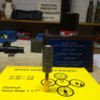I'm not sure why one would want to measure base to tip?? To me that dimension means nothing! You need to know base to ogive or boattail to ogive. The total bullet length in irreverent..
I want to follow up on gstaylorg's responses above, who said it better than I could have, and clarify why I asked the question in the first place.
As I said in my original post: I want to measure base to tip (actually, to sort them by that measurement) in order to point the bullets more consistently.
When I push the bullet into the pointing die, the bullet makes contact at two points: (1) the base of the bullet sits on the shellholder base and (2) the tip of the bullet contacts the die. Neither the ogive, nor the bearing surface, nor anything else other than the base and the tip are contacting anything. Another way of saying it is that the bullet indexes off its base.
If you doubt what I'm saying, insert a 6mm Berger 105 Hybrid into a Whidden no. 1 pointing insert and see what happens. If you don't have those handy, see the attached photo. As you can see, the die doesn't come anywhere close to the ogive. Neither the ogive nor any other part of the bearing surface is touching anything.
If Bullet A is longer (base to tip) than Bullet B and I run both through the die at the same setting, then Bullet A will get pointed more because it goes further up into the die. I can easily, without magnification, see a difference in both the side profile and the amount of meplat closure. In order to point the bullets consistently, I would have to sort them by the base to tip length, the only time that measurement has ever been relevant to me.
Will it make a difference? Gstaylorg makes a compelling case for it. Ditto for Danny Biggs, who is only one of the best F-Class shooters in the country. See http://forum.accurateshooter.com/threads/trimming-and-pointing.3889015/.
To those who provided information to help me with my question, I express my thanks. Your suggestions are very helpful and I appreciate it. To those who wondered why I want to sort them this way, I hope this clarifies it.
Dave Rabin











